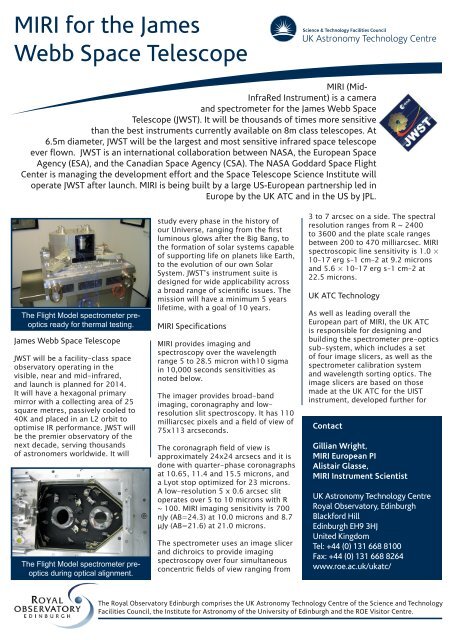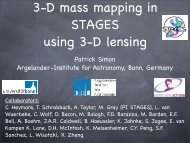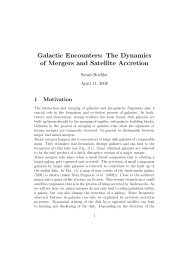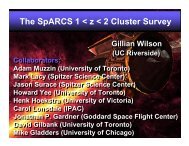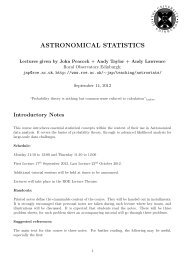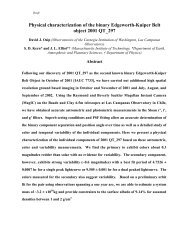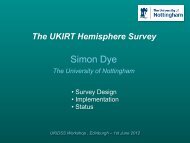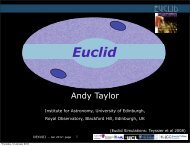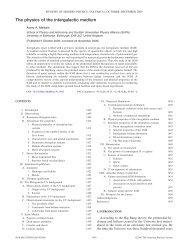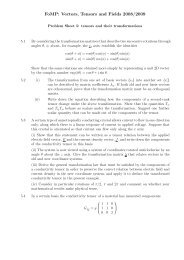MIRI for the James Webb Space Telescope - STFC
MIRI for the James Webb Space Telescope - STFC
MIRI for the James Webb Space Telescope - STFC
Create successful ePaper yourself
Turn your PDF publications into a flip-book with our unique Google optimized e-Paper software.
<strong>MIRI</strong> <strong>for</strong> <strong>the</strong> <strong>James</strong><br />
<strong>Webb</strong> <strong>Space</strong> <strong>Telescope</strong><br />
<strong>MIRI</strong> (Mid-<br />
InfraRed Instrument) is a camera<br />
and spectrometer <strong>for</strong> <strong>the</strong> <strong>James</strong> <strong>Webb</strong> <strong>Space</strong><br />
<strong>Telescope</strong> (JWST). It will be thousands of times more sensitive<br />
than <strong>the</strong> best instruments currently available on 8m class telescopes. At<br />
6.5m diameter, JWST will be <strong>the</strong> largest and most sensitive infrared space telescope<br />
ever flown. JWST is an international collaboration between NASA, <strong>the</strong> European <strong>Space</strong><br />
Agency (ESA), and <strong>the</strong> Canadian <strong>Space</strong> Agency (CSA). The NASA Goddard <strong>Space</strong> Flight<br />
Center is managing <strong>the</strong> development ef<strong>for</strong>t and <strong>the</strong> <strong>Space</strong> <strong>Telescope</strong> Science Institute will<br />
operate JWST after launch. <strong>MIRI</strong> is being built by a large US-European partnership led in<br />
Europe by <strong>the</strong> UK ATC and in <strong>the</strong> US by JPL.<br />
The Flight Model spectrometer preoptics<br />
ready <strong>for</strong> <strong>the</strong>rmal testing.<br />
<strong>James</strong> <strong>Webb</strong> <strong>Space</strong> <strong>Telescope</strong><br />
JWST will be a facility-class space<br />
observatory operating in <strong>the</strong><br />
visible, near and mid-infrared,<br />
and launch is planned <strong>for</strong> 2014.<br />
It will have a hexagonal primary<br />
mirror with a collecting area of 25<br />
square metres, passively cooled to<br />
40K and placed in an L2 orbit to<br />
optimise IR per<strong>for</strong>mance. JWST will<br />
be <strong>the</strong> premier observatory of <strong>the</strong><br />
next decade, serving thousands<br />
of astronomers worldwide. It will<br />
The Flight Model spectrometer preoptics<br />
during optical alignment.<br />
study every phase in <strong>the</strong> history of<br />
our Universe, ranging from <strong>the</strong> first<br />
luminous glows after <strong>the</strong> Big Bang, to<br />
<strong>the</strong> <strong>for</strong>mation of solar systems capable<br />
of supporting life on planets like Earth,<br />
to <strong>the</strong> evolution of our own Solar<br />
System. JWST’s instrument suite is<br />
designed <strong>for</strong> wide applicability across<br />
a broad range of scientific issues. The<br />
mission will have a minimum 5 years<br />
lifetime, with a goal of 10 years.<br />
<strong>MIRI</strong> Specifications<br />
<strong>MIRI</strong> provides imaging and<br />
spectroscopy over <strong>the</strong> wavelength<br />
range 5 to 28.5 micron with10 sigma<br />
in 10,000 seconds sensitivities as<br />
noted below.<br />
The imager provides broad-band<br />
imaging, coronagraphy and lowresolution<br />
slit spectroscopy. It has 110<br />
milliarcsec pixels and a field of view of<br />
75x113 arcseconds.<br />
The coronagraph field of view is<br />
approximately 24x24 arcsecs and it is<br />
done with quarter-phase coronagraphs<br />
at 10.65, 11.4 and 15.5 microns, and<br />
a Lyot stop optimized <strong>for</strong> 23 microns.<br />
A low-resolution 5 x 0.6 arcsec slit<br />
operates over 5 to 10 microns with R<br />
~ 100. <strong>MIRI</strong> imaging sensitivity is 700<br />
nJy (AB=24.3) at 10.0 microns and 8.7<br />
μJy (AB=21.6) at 21.0 microns.<br />
The spectrometer uses an image slicer<br />
and dichroics to provide imaging<br />
spectroscopy over four simultaneous<br />
concentric fields of view ranging from<br />
3 to 7 arcsec on a side. The spectral<br />
resolution ranges from R ~ 2400<br />
to 3600 and <strong>the</strong> plate scale ranges<br />
between 200 to 470 milliarcsec. <strong>MIRI</strong><br />
spectroscopic line sensitivity is 1.0 ×<br />
10–17 erg s–1 cm–2 at 9.2 microns<br />
and 5.6 × 10–17 erg s–1 cm–2 at<br />
22.5 microns.<br />
UK ATC Technology<br />
As well as leading overall <strong>the</strong><br />
European part of <strong>MIRI</strong>, <strong>the</strong> UK ATC<br />
is responsible <strong>for</strong> designing and<br />
building <strong>the</strong> spectrometer pre-optics<br />
sub-system, which includes a set<br />
of four image slicers, as well as <strong>the</strong><br />
spectrometer calibration system<br />
and wavelength sorting optics. The<br />
image slicers are based on those<br />
made at <strong>the</strong> UK ATC <strong>for</strong> <strong>the</strong> UIST<br />
instrument, developed fur<strong>the</strong>r <strong>for</strong><br />
Contact<br />
Gillian Wright,<br />
<strong>MIRI</strong> European PI<br />
Alistair Glasse,<br />
<strong>MIRI</strong> Instrument Scientist<br />
UK Astronomy Technology Centre<br />
Royal Observatory, Edinburgh<br />
Black<strong>for</strong>d Hill<br />
Edinburgh EH9 3HJ<br />
United Kingdom<br />
Tel: +44 (0) 131 668 8100<br />
Fax: +44 (0) 131 668 8264<br />
www.roe.ac.uk/ukatc/<br />
The Royal Observatory Edinburgh comprises <strong>the</strong> UK Astronomy Technology Centre of <strong>the</strong> Science and Technology<br />
Facilities Council, <strong>the</strong> Institute <strong>for</strong> Astronomy of <strong>the</strong> University of Edinburgh and <strong>the</strong> ROE Visitor Centre.
The <strong>MIRI</strong> Verification Model being<br />
prepared <strong>for</strong> <strong>the</strong> cryotest campaign at<br />
RAL.<br />
use in space and at <strong>MIRI</strong>’s much<br />
longer wavelengths.<br />
JWST and <strong>MIRI</strong> Timeline<br />
2008: The <strong>MIRI</strong> Verification Model,<br />
a flight-like copy of <strong>the</strong> instrument<br />
design was built and tested.<br />
This successfully demonstrated<br />
all <strong>the</strong> procedures <strong>for</strong> building<br />
<strong>the</strong> instrument, <strong>for</strong> testing and<br />
calibrations as well as <strong>the</strong> scientific<br />
per<strong>for</strong>mance of <strong>the</strong> spectrometer,<br />
imager and coronagraphs.<br />
2009: Delivery of all <strong>the</strong> flight model<br />
sub-systems, including <strong>the</strong> UK<br />
ATC’s spectrometer pre-optics to<br />
RAL <strong>for</strong> assembly into <strong>the</strong> flight <strong>MIRI</strong><br />
Instrument.<br />
2009: Delivery of <strong>the</strong> <strong>MIRI</strong><br />
Structural-Thermal model (<strong>MIRI</strong><br />
STM), shown in <strong>the</strong> picture below<br />
The <strong>MIRI</strong> Structural-Thermal Model.<br />
undergoing alignment measurements<br />
at RAL, to Goddard. Thermal and<br />
vibration testing of <strong>the</strong> <strong>MIRI</strong> STM <strong>the</strong>re<br />
will provide accurate data <strong>for</strong> <strong>the</strong><br />
environments <strong>MIRI</strong> must be shown to<br />
be capable of withstanding.<br />
2010: Delivery of <strong>the</strong> flight <strong>MIRI</strong> to<br />
<strong>the</strong> Goddard <strong>for</strong> testing along with<br />
<strong>the</strong> o<strong>the</strong>r JWST instruments prior to<br />
integration with <strong>the</strong> telescope.<br />
2012: Integration of <strong>the</strong> instruments<br />
and telescope, followed by end-end<br />
testing be<strong>for</strong>e integration with <strong>the</strong><br />
spacecraft begins.<br />
2013: Cycle 1 call <strong>for</strong> General Observer<br />
Proposals, to be carried out in <strong>the</strong> first<br />
year of <strong>the</strong> mission, will be issued by<br />
STScI.<br />
2014: Launch.<br />
The <strong>MIRI</strong> Team<br />
<strong>MIRI</strong> draws on <strong>the</strong> expertise of<br />
<strong>the</strong> following organizations: Ames<br />
Research Center, USA; Astrium, Ltd.,<br />
U.K; ASTRON, Ne<strong>the</strong>rlands Foundation<br />
<strong>for</strong> Research in Astronomy; CEA Service<br />
d’Astrophysique, Saclay, France;<br />
Centre Spatial de Liége, Belgium;<br />
Consejo Superior de Investigacones<br />
Científicas, Spain; Cranfield Univ,<br />
UK; Danish <strong>Space</strong> Research Institute;<br />
Dublin Institute <strong>for</strong> Advanced Studies,<br />
Ireland; ETKA, Belgium; ESTEC,<br />
Ne<strong>the</strong>rlands; Institute d’Astrophysique<br />
Spatiale, France; Instituto Nacional<br />
de Técnica Aerospacial, Spain; ETH,<br />
Zurich, Switzerland; Jet Propulsion<br />
Laboratory, USA; Laboratoire<br />
d’Astrophysique de Marseille<br />
(LAM), France; Lockheed Advanced<br />
Technology Center, USA; Max-<br />
Planck-Insitut für Astronomie (MPIA),<br />
Heidelberg, Germany; Observatoire<br />
de Paris, France; Observatory of<br />
Geneva, Switzerland; Paul Scherrer<br />
Institut, Switzerland; Onsala <strong>Space</strong><br />
Observatory, Sweden Physikalishes<br />
Institut, Bern, Switzerland; Ray<strong>the</strong>on<br />
Vision Systems, USA; Ru<strong>the</strong>r<strong>for</strong>d<br />
Appleton Laboratory (RAL), UK; <strong>Space</strong><br />
<strong>Telescope</strong> Science Institute, USA;<br />
VM test spectra<br />
being displayed<br />
using <strong>the</strong> DHAS<br />
quicklook tool.<br />
Toegepast-Natuurwetenschappelijk<br />
Ondeszoek (TNO-TPD), Ne<strong>the</strong>rlands;<br />
UK Astronomy Technology Centre<br />
(UK ATC); Univ. of Amsterdam,<br />
Ne<strong>the</strong>rlands; Univ. of Arizona,<br />
USA; Univ. of Cardiff, UK; Univ.<br />
of Cologne, Germany; Univ. of<br />
Groningen, Ne<strong>the</strong>rlands; Univ.<br />
of Leicester, UK; Univ. of Leiden,<br />
Ne<strong>the</strong>rlands; Univ. of Leuven,<br />
Belgium; Univ. of Stockholm,<br />
Sweden; Univ. of Reading, UK; Utah<br />
State Univ. USA; Zeiss, Germany<br />
The <strong>MIRI</strong> development is supported<br />
by <strong>the</strong> following national agencies<br />
Belgian Science Policy Office<br />
(BELSPO), Centre Nationale D’Etudes<br />
Spatiales (CNES), Danish National<br />
<strong>Space</strong> Centre, Deutsches Zentrum<br />
fur Luft-und Raumfahrt (DLR),<br />
Enterprise Ireland, ESA, Ministerio<br />
De Education y Ciencia, NASA, Nova,<br />
Science and Technology Facilities<br />
Council (<strong>STFC</strong>), Swiss <strong>Space</strong> Office,<br />
Swedish National <strong>Space</strong> Board.<br />
For more in<strong>for</strong>mation about JWST<br />
and all <strong>the</strong> instruments, see Gardner<br />
et al. 2006, <strong>Space</strong> Science Reviews,<br />
123, 485. You can register <strong>for</strong> <strong>the</strong><br />
mission newsletter email distribution<br />
at https://lists.nasa.gov/mailman/<br />
listinfo/gsfc-jwst-update or<br />
download <strong>the</strong>m from http://www.<br />
jwst.nasa.gov<br />
One of <strong>the</strong> four image slicer mirrors.


